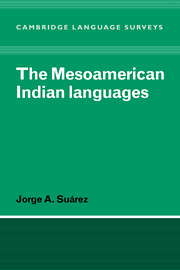Book contents
- Frontmatter
- Contents
- List of illustrations
- List of tables
- Preface
- Notational conventions
- Map 1 Present-day distribution of Mesoamerican Indian languages
- Table 1 Classification of Mesoamerican Indian languages and index to map 1
- 1 The study of Mesoamerican Indian languages
- 2 Dialects, languages and linguistic families
- 3 Phonology I
- 4 Phonology II
- 5 Morphology I
- 6 Morphology II
- 7 Syntax I
- 8 Syntax II
- 9 Preconquest literary traditions
- 10 The prehistory of Mesoamerican Indian languages
- 11 Indian languages after the conquest
- Appendix: Sources for sentences quoted in chapters 7 and 8
- References
- Language index
- Subject index
2 - Dialects, languages and linguistic families
Published online by Cambridge University Press: 05 November 2009
- Frontmatter
- Contents
- List of illustrations
- List of tables
- Preface
- Notational conventions
- Map 1 Present-day distribution of Mesoamerican Indian languages
- Table 1 Classification of Mesoamerican Indian languages and index to map 1
- 1 The study of Mesoamerican Indian languages
- 2 Dialects, languages and linguistic families
- 3 Phonology I
- 4 Phonology II
- 5 Morphology I
- 6 Morphology II
- 7 Syntax I
- 8 Syntax II
- 9 Preconquest literary traditions
- 10 The prehistory of Mesoamerican Indian languages
- 11 Indian languages after the conquest
- Appendix: Sources for sentences quoted in chapters 7 and 8
- References
- Language index
- Subject index
Summary
The term ‘Mesoamerica’ is not synonymous with ‘Central America’, which excludes Mexico but extends as far as Panama, nor with ‘Middle America’, a more technical, geographical term covering Mexico and Central America. Mesoamerica designates an area that is neither a geographical region nor a political unit, but rather a culture area defined on the basis of common characteristics that were present during preconquest times (cf. chapter 10). In spite of the fact that the conquest produced changes that in more than one sense reshaped the area, there was a certain cultural continuity resulting from the survival of many indigenous groups that had come under the influence of a new but single cultural tradition. From a linguistic point of view the area is rather well defined in the sense that most of the language families found there do not extend beyond its limits.
The linguistic map
The first step involved in becoming acquainted with a linguistic area is to discover which languages are spoken in it, their geographical location and their classification. This information is given in map 1 and table 1 (above). The linguistic families and subgroups listed follow approximately a north-to-south order. Languages included are for the most part still spoken and the map gives their present-day location, although some which are shown became extinct during the nineteenth or twentieth centuries. By ‘extinct’ we mean that the language is no longer in common use in a community, although there may still be some speakers.
- Type
- Chapter
- Information
- The Mesoamerican Indian Languages , pp. 11 - 29Publisher: Cambridge University PressPrint publication year: 1983



